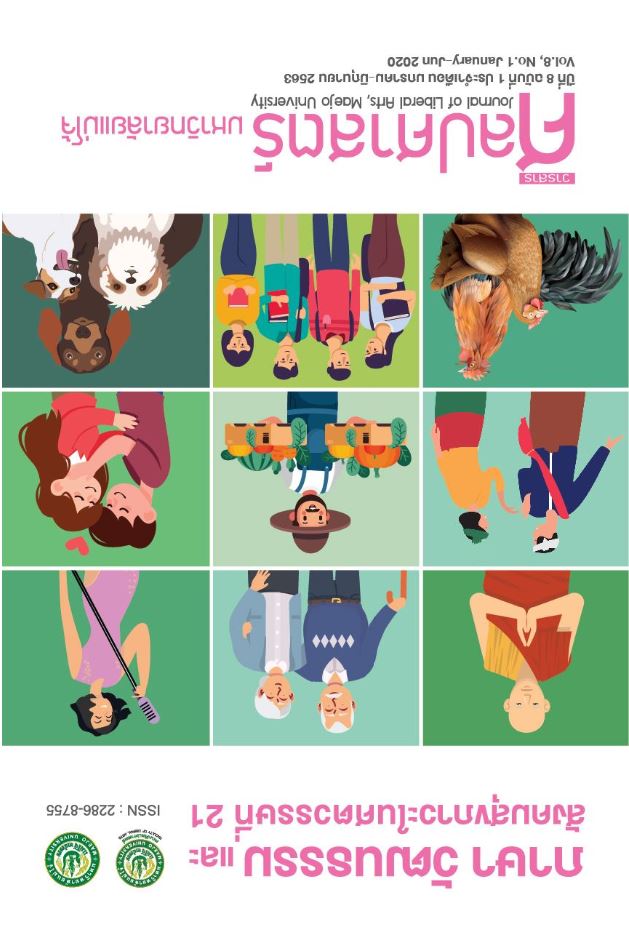Bot Lakhon Rueang Dalang with the Given Number 35: A Missing Ayutthaya Version of the Dalang
Main Article Content
Abstract
Bot Lakhon Rueang Dalang, which was typed in 30 pages of paper with the given number of 35, was copied from a folded paper book (Samut Thai) and is now kept in the National Library of Thailand. It narrates the story from the scene in which Inao asked the king of Kurepan to go hunting, and moves forward to the scene in which Tammangong put Butsabasari, Inao’s consort, to death. Bot Lakhon Rueang Dalang number 35 is a different version of Bot Lakhon Rueang Dalang of King Rama I and has no information about the author and the history of composition. This article aims to examine the characteristics and the date of composition of Bot Lakhon Rueang Dalang number 35 by comparing it with the Dalang of King Rama I which is the oldest version of the Dalang in survival today. The study finds that various characteristics of Bot Lakhon Rueang Dalang number 35 are different from the Dalang of King Rama I. It presents some contents and characters different from those in the Dalang of King Rama I, it has more simple literary techniques than those in the Dalang of King Rama I, it uses the Klon style and some words like those found in Bot Lakhon of Ayutthaya and Thonburi periods, and it presents more concise continuity of the story than that in the Dalang of King Rama I while still containing descriptions appropriate for transformation into beautiful dances. Those distinctive characteristics indicate that Bot Lakhon Rueang Dalang number 35 might be a fragmented manuscript from the Dalang of the late-Ayutthaya period where the Dalang was first composed. Bot Lakhon Rueang Dalang number 35, therefore, should be recognized as a significant version of the Dalang demonstrating that the Ayutthaya version of the Dalang is not entirely lost and extending the knowledge of the Dalang literature and performance.
Article Details
References
ตากสินมหาราช, สมเด็จพระเจ้า. (2506). บทละครรามเกียรติ์. กรุงเทพฯ : องค์การค้าของคุรุสภา.
ธานีรัตน์ จัตุทะศรี. (2561). “เมื่อเกิดมาเป็นสตรี จะสงวนประเวณีให้แจ่มใส”: การนำเสนอตัวละครหญิงเพื่อสอนหญิงในเรื่องดาหลังพระราชนิพนธ์ในรัชกาลที่ 1. วารสารไทยศึกษา. 14(2), 151-198.
ธานีรัตน์ จัตุทะศรี. (2562ก). บทละครเรื่องดาหลังฉบับสมุดไทยเลขที่ 516/1: เรื่องดาหลังสำนวนแปลก. วารสารภาษาและวรรณคดีไทย. 36(2), 67-109.
ธานีรัตน์ จัตุทะศรี. (2562ข). บทละครเรื่องดาหลังฉบับหมื่นจำเนียร: เรื่องดาหลังสำนวนเก่าที่เพิ่งพบ. วารสารอักษรศาสตร์. 48(2), 146-173.
พิทยลาภพฤฒิยากร, พระวรวงศ์เธอ กรมหมื่น. (2517). ชุมนุมพระนิพนธ์ของพระวรวงศ์เธอ กรมหมื่นพิทยลาภพฤฒิยากร. กรุงเทพฯ : โรงพิมพ์พระจันทร์.
พุทธยอดฟ้าจุฬาโลก, พระบาทสมเด็จพระ. (2499). ดาหลัง. กรุงเทพฯ : รุ่งเรืองธรรม. (พระบาทสมเด็จพระเจ้าอยู่หัวทรงพระกรุณาโปรดเกล้าให้พิมพ์พระราชทานในงานถวายพระเพลิงพระบรมศพสมเด็จพระศรีสวรินทิราบรมราชเทวี พระพันวัสสาอัยิกาเจ้า ณ พระเมรุมาศท้องสนามหลวง วันที่ 22 เมษายน พ.ศ. 2499)
ราชบัณฑิตยสถาน. (2546). พจนานุกรม ฉบับราชบัณฑิตยสถาน พ.ศ. 2542. กรุงเทพฯ : นานมีบุ๊คส์พับลิเคชั่นส์.
เรื่องดาหลังความเก่า. กระดาษฝรั่ง. เลขที่ 35 ตู้ 115 ชั้น 4/4 มัดที่ 6. หมู่กลอนบทละคร. หอสมุดแห่งชาติ. กรุงเทพฯ.
วรรณคดีสมัยกรุงศรีอยุธยา. (2526). กรุงเทพฯ : บรรณกิจ.
ศูนย์หม่อนไหมเฉลิมพระเกียรติฯ นราธิวาส กรมหม่อนไหม. (2555, 11 ธันวาคม). ผ้าโบราณ “จวนตานี” มรดกประวัติศาสตร์ที่ถูกลืม. สืบค้นเมื่อ 6 มกราคม 2563 จาก https://www.gotoknow.org/posts/445029
เสาวณิต วิงวอน. (2555). วรรณคดีการแสดง. พิมพ์ครั้งที่ 2. กรุงเทพฯ : ภาควิชาวรรณคดี และคณะกรรมการฝ่ายวิจัย คณะมนุษยศาสตร์ มหาวิทยาลัยเกษตรศาสตร์.
เสาวลักษณ์ อนันตศานต์. (2515). บทละครนอกสมัยกรุงศรีอยุธยา. (วิทยานิพนธ์มหาบัณฑิต). กรุงเทพฯ :จุฬาลงกรณ์มหาวิทยาลัย.

